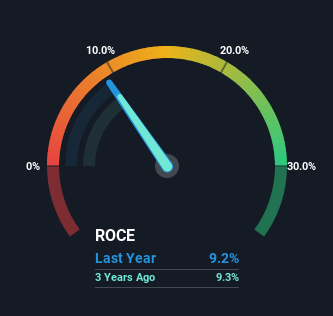Zhongyin Babi Food (SHSE:605338) Will Be Hoping To Turn Its Returns On Capital Around

If we want to find a stock that could multiply over the long term, what are the underlying trends we should look for? Ideally, a business will show two trends; firstly a growing return on capital employed (ROCE) and secondly, an increasing amount of capital employed. This shows us that it's a compounding machine, able to continually reinvest its earnings back into the business and generate higher returns. However, after briefly looking over the numbers, we don't think Zhongyin Babi Food (SHSE:605338) has the makings of a multi-bagger going forward, but let's have a look at why that may be.
Return On Capital Employed (ROCE): What Is It?
For those that aren't sure what ROCE is, it measures the amount of pre-tax profits a company can generate from the capital employed in its business. The formula for this calculation on Zhongyin Babi Food is:
Return on Capital Employed = Earnings Before Interest and Tax (EBIT) ÷ (Total Assets - Current Liabilities)
0.092 = CN¥218m ÷ (CN¥2.8b - CN¥410m) (Based on the trailing twelve months to March 2024).
Therefore, Zhongyin Babi Food has an ROCE of 9.2%. On its own that's a low return, but compared to the average of 7.6% generated by the Food industry, it's much better.
Check out our latest analysis for Zhongyin Babi Food

Above you can see how the current ROCE for Zhongyin Babi Food compares to its prior returns on capital, but there's only so much you can tell from the past. If you're interested, you can view the analysts predictions in our free analyst report for Zhongyin Babi Food .
How Are Returns Trending?
In terms of Zhongyin Babi Food's historical ROCE movements, the trend isn't fantastic. Over the last five years, returns on capital have decreased to 9.2% from 25% five years ago. Meanwhile, the business is utilizing more capital but this hasn't moved the needle much in terms of sales in the past 12 months, so this could reflect longer term investments. It may take some time before the company starts to see any change in earnings from these investments.
On a side note, Zhongyin Babi Food has done well to pay down its current liabilities to 15% of total assets. That could partly explain why the ROCE has dropped. What's more, this can reduce some aspects of risk to the business because now the company's suppliers or short-term creditors are funding less of its operations. Since the business is basically funding more of its operations with it's own money, you could argue this has made the business less efficient at generating ROCE.
What We Can Learn From Zhongyin Babi Food's ROCE
To conclude, we've found that Zhongyin Babi Food is reinvesting in the business, but returns have been falling. And investors appear hesitant that the trends will pick up because the stock has fallen 56% in the last three years. In any case, the stock doesn't have these traits of a multi-bagger discussed above, so if that's what you're looking for, we think you'd have more luck elsewhere.
One more thing to note, we've identified 1 warning sign with Zhongyin Babi Food and understanding it should be part of your investment process.
If you want to search for solid companies with great earnings, check out this free list of companies with good balance sheets and impressive returns on equity.
Valuation is complex, but we're here to simplify it.
Discover if Zhongyin Babi Food might be undervalued or overvalued with our detailed analysis, featuring fair value estimates, potential risks, dividends, insider trades, and its financial condition.
Access Free AnalysisHave feedback on this article? Concerned about the content? Get in touch with us directly. Alternatively, email editorial-team (at) simplywallst.com.
This article by Simply Wall St is general in nature. We provide commentary based on historical data and analyst forecasts only using an unbiased methodology and our articles are not intended to be financial advice. It does not constitute a recommendation to buy or sell any stock, and does not take account of your objectives, or your financial situation. We aim to bring you long-term focused analysis driven by fundamental data. Note that our analysis may not factor in the latest price-sensitive company announcements or qualitative material. Simply Wall St has no position in any stocks mentioned.
About SHSE:605338
Zhongyin Babi Food
Engages in the research and development, production, and sale of Chinese pastry and frozen food.
Flawless balance sheet and good value.
Market Insights
Community Narratives




